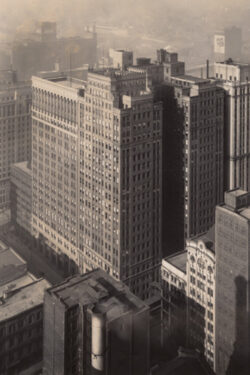Two scholars of the skyscraper, Kathryn Holliday, and Carol Willis address an opposition that has long characterized the framework for understanding the history of tall buildings – corporate vs. commercial – and ask: “What do those words mean, and how do they apply to skyscraper history?”
The program focuses which architects generally call “program.” Office, residential, manufacturing, and commercial (meaning rental) are the terms that generally describe the different uses of high-rise buildings. Yet, one can argue that the most basic commonality in the vast majority of skyscrapers is that they are buildings erected to produce space for rent: i.e., all these uses are urban commercial architecture.
The idea of “corporate architecture” as applied to skyscrapers needs new scrutiny, especially in the early age of the rise of the corporation in the U.S. and especially in New York City in the last decades of the 19th century. Certainly, corporate headquarters, “branding,” and competition played a role in the inspiration and investment in early skyscrapers, as Holliday illustrates. But, as Willis argues, most “corporate” buildings included a significant portion of rental space, and from the 1890s, speculative real estate drove both the height and volume of high-rise construction.
This discussion builds on several past lectures at The Skyscraper Museum by each speaker: the videos of these previous talks are highly recommended as background.
Kathryn Holliday, Vertical Expansion: Telephone Infrastructure and Density in the Urban Market
Kathryn Holliday, A Tower To “Wake Up the Nation:” the New York Times in Times Square
Speakers
Kathryn Holliday, Professor of Architectural History in the School of Architecture at University of Texas Arlington, is an architectural historian of American architecture in the 19th and 20th centuries. She is the author of Leopold Eidlitz: Architecture and Idealism in the Gilded Age (W. W. Norton, 2008) and Ralph Walker: Architect of the Century (Rizzoli, 2012). Her current research focuses on a history of telephone buildings since the invention of commercial telephone service by Alexander Graham Bell in 1876, titled “Telephone City” and an examination of the postwar boom in architecture in the suburban landscape of Dallas and Fort Worth in the 1960s and 1970s.
Carol Willis is the founder, director, and curator of The Skyscraper Museum. She is the author of Form Follows Finance: Skyscrapers and Skylines in New York and Chicago (Princeton Architectural Press, 1995), among other publications. An Adjunct Associate Professor of Urban Studies at Columbia University's GSAPP, she teaches in the program Shape of Two Cities: New York and Paris.
